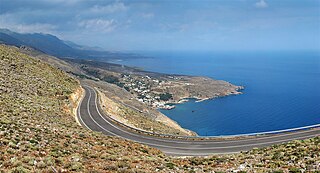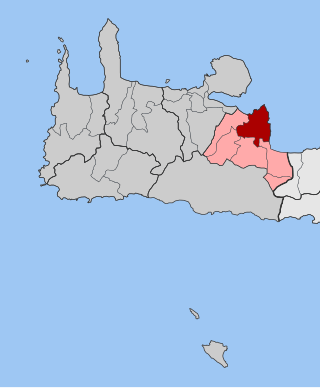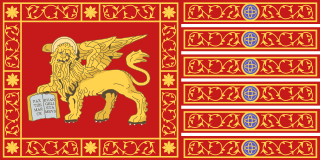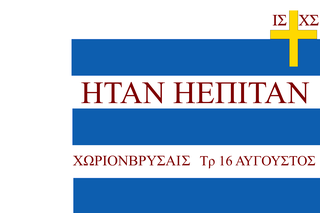
Crete is the largest and most populous of the Greek islands, the 88th largest island in the world and the fifth largest island in the Mediterranean Sea, after Sicily, Sardinia, Cyprus, and Corsica. Crete is located about 100 km (62 mi) south of the Peloponnese, and about 300 km (190 mi) southwest of Anatolia. Crete has an area of 8,450 km2 (3,260 sq mi) and a coastline of 1,046 km (650 mi). It bounds the southern border of the Aegean Sea, with the Sea of Crete to the north and the Libyan Sea to the south. Crete covers 260 km from west to east but is narrow from north to south, spanning three longitudes but only half a latitude.

Chania, also sometimes romanized as Hania, is a city in Greece and the capital of the Chania regional unit. It lies along the north west coast of the island Crete, about 70 km (43 mi) west of Rethymno and 145 km (90 mi) west of Heraklion.

The history of Crete goes back to the 7th millennium BC, preceding the ancient Minoan civilization by more than four millennia. The Minoan civilization was the first civilization in Europe.

Sfakiá is a mountainous area in the southwestern part of the island of Crete, in the Chania regional unit. It is considered to be one of the few places in Greece that have never been fully occupied by foreign powers. With a 2021 census population of 2,002 inhabitants living on a land area of 467.589 km2 (180.537 sq mi), Sfakia is one of the largest and least densely populated municipalities on the island of Crete. The etymology of its name is disputed. According to the prevailing theory, it relates to its rugged terrain, deriving from the ancient Greek word σφαξ, meaning land chasm or gorge.

Palaiochora is a small town in Chania regional unit, Greece. It is located 70 km south of Chania, on the southwest coast of Crete and occupies a small peninsula 400 m wide and 700 m long. The town is set along 11 km of coastline bordering the Libyan Sea. It is the seat of the municipality of Kantanos–Selino and its population was 2,181 in the 2021 census.

Vamos is a small town and former municipality in the Chania regional unit, Crete, Greece. Since the 2011 local government reform "Kallikratis" it is a municipal unit, part of the municipality of Apokoronas, serving as its historical capital. It is situated on a small hill at an altitude of 190 metres above sea level, about 25 kilometres from Chania. In Vamos, one can find several restaurants, snack bars and shops in the village, as well as many public services, such as a fully equipped health center, schools, police station and the regional court for the regions of Apokoronas and Sfakia.

Chania, also spelled Hania, is one of the four regional units of Crete; it covers the westernmost quarter of the island. Its capital is the city of Chania. Chania borders only one other regional unit: that of Rethymno to the east. The western part of Crete is bounded to the north by the Cretan Sea and to the west and south by the Mediterranean Sea and Libyan Sea. The regional unit also includes the southernmost island of Europe, Gavdos.

The Sfakians are the inhabitants of the region of Sfakia located in western Crete. The Sfakians hold themselves to be the direct descendants of the Dorians who came down to Crete around 1100 BC.

Xirosterni is a village and a community located in the Apokoronas region close to the northwest coast of the island of Crete, Greece, in Chania regional unit. The community consists of the settlements Xirosterni and Litsarda. It is approximately 25 kilometres (16 mi) from Chania.

Lefka Ori or Madares is a mountain range located in Western Crete, in the Chania prefecture. The White Mountains or Lefka Ori occupy a large part of the centre of West Crete and are the main feature of the region. They consist mainly of limestone, from light grey to bluish or black color. The White Mountains have taken their name from the perpetual white or off-white color of their peaks as the off white of limestone during the summer and fall interchanges with the snow that covers the peaks until late in spring.
The Pact of Halepa or Halepa Charter was an agreement made in 1878 between the Ottoman Empire and the representatives of the Cretan Revolutionary Committee, which secured wide-ranging autonomy for the island of Crete. It was named after the place where it was signed, Halepa.

The Cretan State was established in 1898, following the intervention by the Great Powers on the island of Crete. In 1897, the Cretan Revolt led the Ottoman Empire to declare war on Greece, which led the United Kingdom, France, Italy and Russia to intervene on the grounds that the Ottoman Empire could no longer maintain control. It was the prelude to the island's final annexation to the Kingdom of Greece, which occurred de facto in 1908 and de jure in 1913 after the First Balkan War.

The Cretan revolt of 1866–1869 or Great Cretan Revolution was a three-year uprising in Crete against Ottoman rule, the third and largest in a series of Cretan revolts between the end of the Greek War of Independence in 1830 and the establishment of the independent Cretan State in 1898.

The Theriso revolt was an insurrection that broke out in March 1905 against the government of Crete, then an autonomous state under Ottoman suzerainty. The revolt was led by the Cretan politician Eleftherios Venizelos, and is named after his mother's native village, Theriso, the focal point of the revolt.

The Realm or Kingdom of Candia or Duchy of Candia was the official name of Crete during the island's period as an overseas colony of the Republic of Venice, from the initial Venetian conquest in 1205–1212 to its fall to the Ottoman Empire during the Cretan War (1645–1669). The island was at the time and up to the early modern era commonly known as Candia after its capital, Candia or Chandax. In modern Greek historiography, the period is known as the Venetocracy.
Omalos is a small village in western Crete, in the Mousouroi unit of the Chania region. The Greek word Ομαλός means even, plain, regular, or smooth, referring to the plateau.

Michail Korakas was a Cretan revolutionary, who played a major role in successive Cretan revolts against the Ottoman Empire in 1821–29, 1841, 1858, 1866–69, and 1878.

Theodoros Koukoulakis was a Greek revolutionary and a minor leader of the Macedonian Struggle.

The Cretan revolt of 1878 was an insurrection of the Cretan people against the Ottoman occupation of the island. This insurrection is part of a larger movement for independence from the Ottoman Empire, which Crete was part of since the middle of the 17th century.

The Cretan Revolt of 1897–1898 was a successful insurrection by the Greek Orthodox population of Crete against the rule of the Ottoman Empire after decades of rising tensions. The Greek insurrectionists received supplies and armed support first from the Kingdom of Greece; then later from the Great Powers: the United Kingdom, France, Italy, Austria-Hungary, Germany and Russia. The conflict ended in 1898 with Cretan-allied victory and Ottoman retreat when the Great Powers cut their funding and proposed a resolution which stipulated:
- The Island of Crete become an autonomous state under the nominal sovereignty of the Ottoman Empire, with the Prince George of Greece as governor.
- The Ottoman Empire recognize the sovereignty of the Kingdom of Greece.
- The Kingdom of Greece recognize the sovereignty of the Ottoman Empire.




















